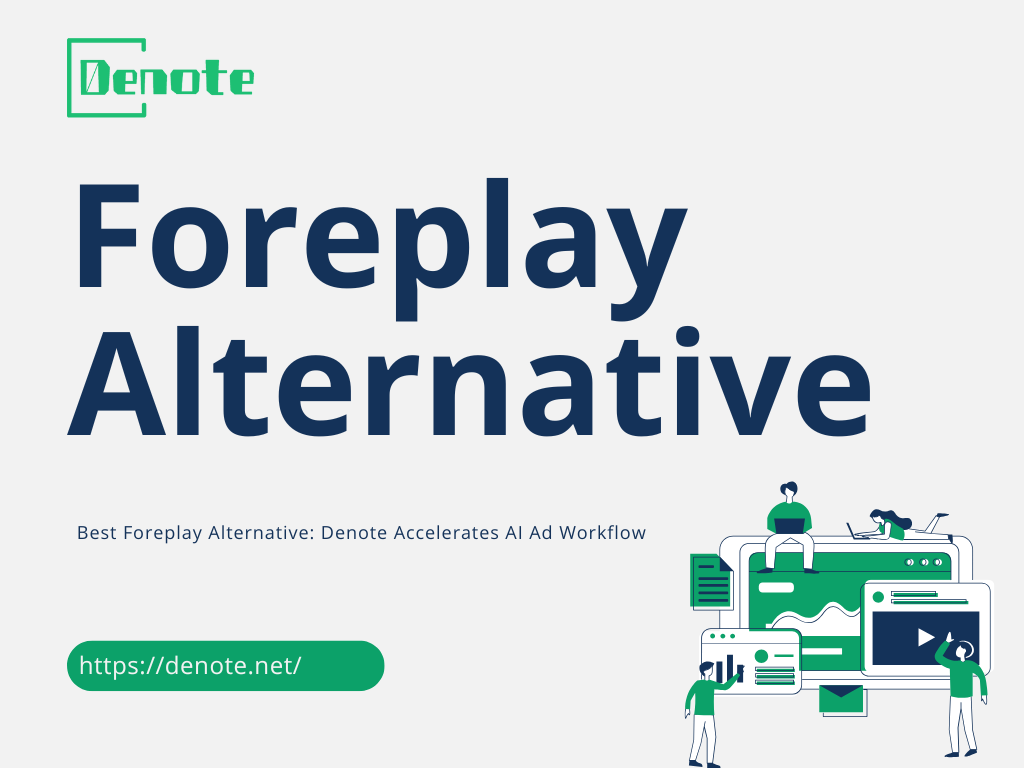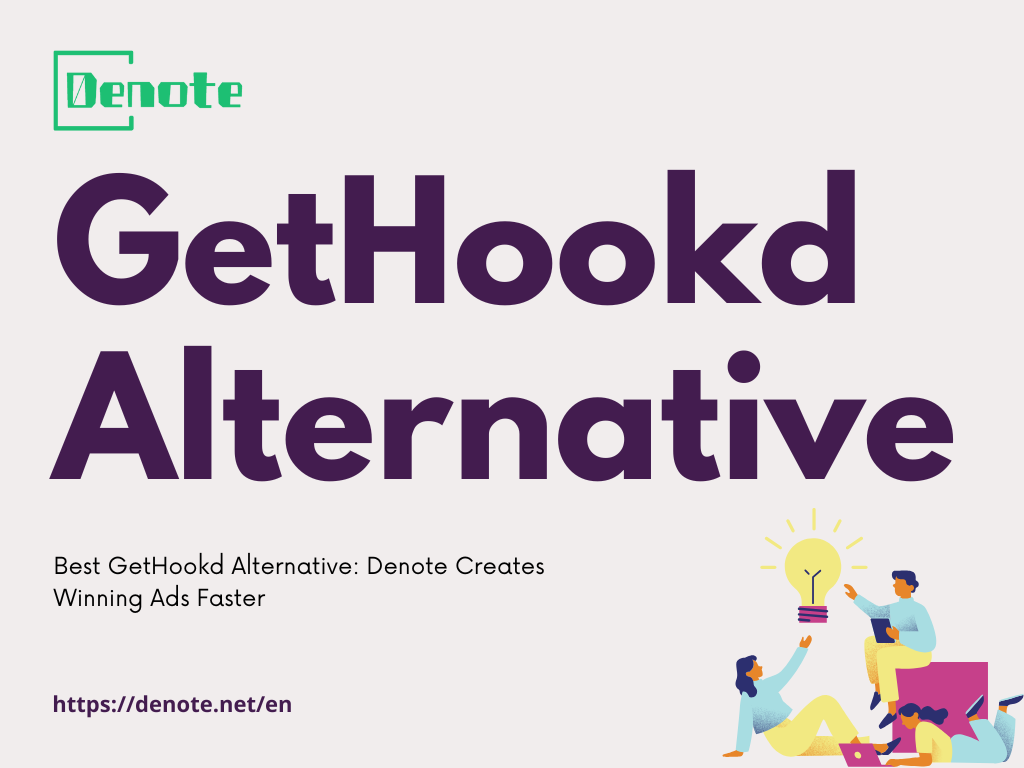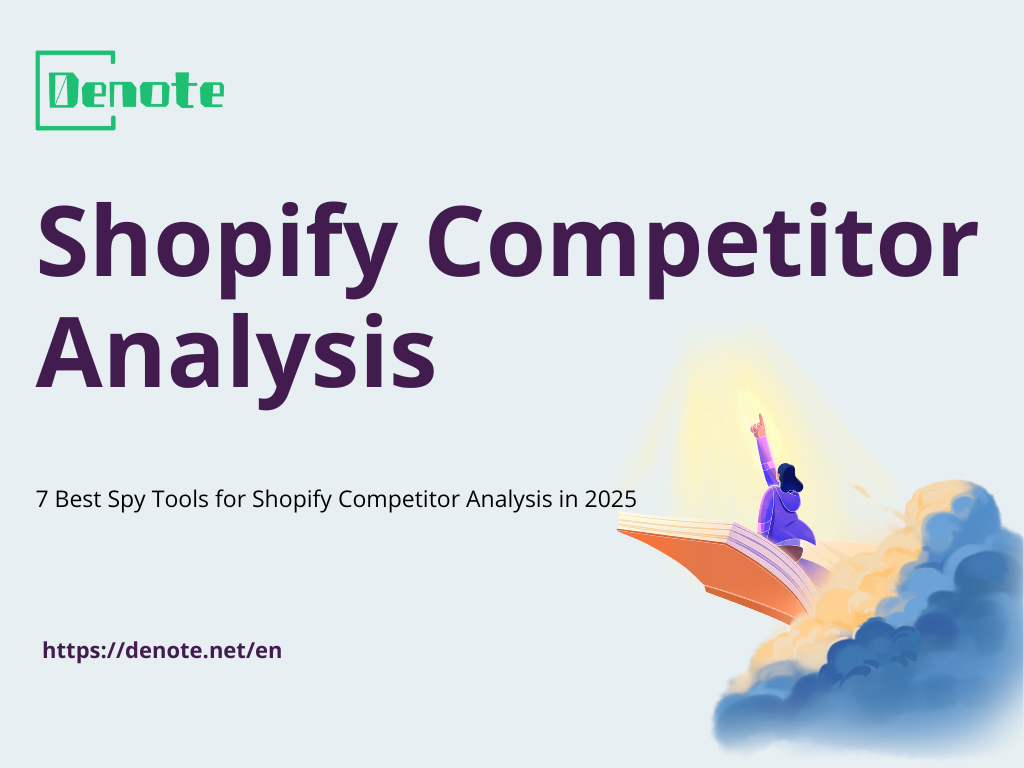Facebook Andromeda: 7 Proven Tactics for Better Ad Results
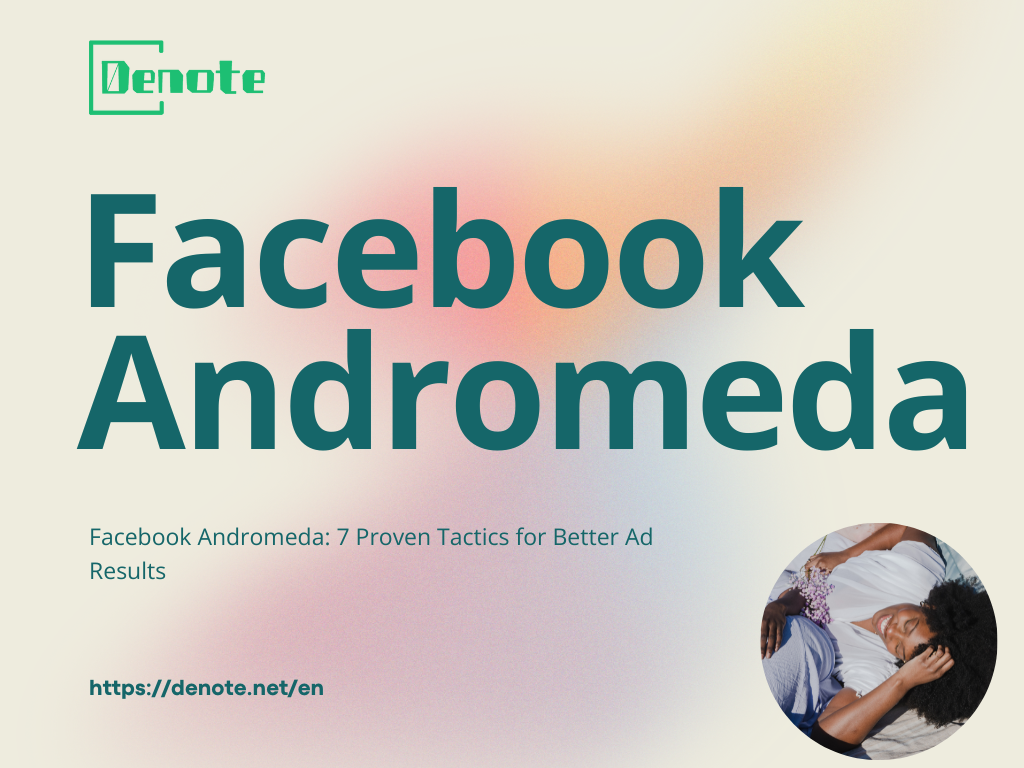
- Why Facebook Andromeda Changes Everything
-
7 Proven Tactics to Improve Ad Performance
- (Tactic 1): Prioritize creative diversity
- (Tactic 2): Use broad targeting for faster learning
- (Tactic 3): Combine automation with human control
- (Tactic 4): Test creatives with structured A/B flow
- (Tactic 5): Strengthen first-party signals
- (Tactic 6): Optimize for long-term value
- (Tactic 7): Keep adapting to algorithm shifts
- Putting It All Together
- Common Mistakes to Avoid
- Conclusion
Why Facebook Andromeda Changes Everything
What is Facebook Andromeda
Think of Facebook Andromeda as Meta’s new brain for ad matching — a high-capacity retrieval and ranking engine that sifts billions of potential creative-user pairs and narrows them down to the handful most likely to convert. It’s not a single tweak to bidding or targeting; it’s a fundamental rework of how ads are retrieved, ranked, and delivered. In short: Andromeda decides which ads are eligible for an impression before the bidding even happens, and it does so with orders of magnitude more compute and nuance than the older system.
That means the old checklist — build 20 tiny audiences, clone an ad, tweak a headline, repeat — is now a less reliable path to scaling. Andromeda rewards signal richness and creative variety, not just clever audience hacks. Advertisers must stop treating the platform like a set of levers they can pull precisely; Andromeda learns patterns across creative, behaviors, and context and then serves the best fit.
Key changes and new ad logic
Here are the headline effects you’ll see if you’ve been running Meta ads recently:
- Creative signals trump tiny audience splits. The system now evaluates creative combinations (visual, copy, format) more deeply, meaning creative breadth often outperforms micro-targeting.
- Simpler campaign structures learn faster. Broad audiences and consolidated budgets reduce internal competition and speed up the learning phase. Practitioners are converging on “one campaign, one ad set” models for many use cases.
- Automation is amplified — but not omnipotent. Advantage+ and other Meta automation suites plug into Andromeda; they can scale, but they also need high-quality assets and signal to work well.
Imagine Andromeda as an extremely picky matchmaker. If you bring one photograph and one line of copy, you have a tiny chance of being chosen. Bring a portfolio of well-engineered creatives and rich event signals? Andromeda stacks the deck in your favor.
Why it matters for advertisers
If you care about things like ROAS, CPA, or just making more money in the long run, Facebook Andromeda changes the game. It used to be all about how sharp you were with targeting, but now, the real advantage comes from strong creative work, solid first-party data, and knowing how to handle automation.
This shift is a double-edged sword. On one hand, it’s great—smaller teams with fresh ideas and solid creative chops can beat out bloated accounts that just rely on endless tweaks. But on the flip side, if you ignore your creative, slack off on tracking, or scatter your budget, you’ll get left behind fast. Basically, Andromeda rewards people who actually build things, not those who just fiddle around the edges.
7 Proven Tactics to Improve Ad Performance
Each tactic below is a practical move you can implement this week. They are battle-tested by advertisers who rebuilt their pipelines after the Andromeda rollout, and they’re engineered to work together — like gears in a clock, not isolated buttons.

(Tactic 1): Prioritize creative diversity
If Facebook Andromeda were a recipe, creative diversity would be that extra kick nobody tells you about. This engine loves options—different angles, fresh formats, and a mix of emotional hooks. One decent ad just doesn’t cut it. Usually, a bunch of unique creatives, each speaking to a different motivation, wins out every time.
- Why this works: Andromeda evaluates which creative variant is most likely to trigger a specific person’s action. The system needs multiple creative candidates to match different micro-intents.
- What to build: Assemble a creative pool of 8–12 assets per funnel stage — short reels, static thumbnails, carousel comparisons, UGC clips, and 10–15 headline/body variants.
Focus on ideas, not narrow targeting
Stop thinking “who to target” first; start with “what to say.” A creative matrix that explores benefits, pain points, social proof, scarcity, and founder stories gives Andromeda richer signals to work with. Narrow audience splits that starve each ad of impressions are less useful than a broad test of diverse ideas.
(Tactic 2): Use broad targeting for faster learning
The paradox of modern Meta ads is this: broad equals faster learning. By opening the door wider, Andromeda can find signal patterns faster across demographics and contexts.
- Quick rule: Use broader targeting with clean exclusions rather than dozens of narrow segmented ad sets. Let the system discover pockets of performance.
One campaign, one ad set principle
Consolidate budgets into fewer ad sets. That reduces internal budget cannibalization and concentrates learning. For many e-commerce and prospecting funnels, a “one campaign, one ad set” approach — with multiple creatives inside — produces clearer winners faster.
(Tactic 3): Combine automation with human control
Automation is powerful, but it’s a tool — not a tyrant. Facebook Andromeda and Advantage+ give you scale; you still need rules, guardrails, and human judgment.
- How to balance: Use Advantage+ or other automated bids and placements to let Andromeda allocate delivery, but set manual KPIs for brand safety, incremental cost limits, and creative guardrails. Humans should define the objective, thresholds, and cadence for reviews.
Keep manual KPIs for balance
Keep a shortlist of manual KPIs (ROAS floor, CPA ceiling, click quality, brand safety flags). These stop automation from chasing short-term wins that hurt long-term value. Think of automation as the engine and your KPIs as the steering wheel.
(Tactic 4): Test creatives with structured A/B flow
Random testing is chaos. Structured A/B (or A/B/n) testing gives Andromeda reliable signals by controlling for variables and replacing losers quickly.
- Process: Launch parallel creative batches, let them run to statistical thresholds, then retire the bottom 20–40% while doubling down on top performers. Keep a cadence of rotation to avoid creative fatigue and to feed Andromeda fresh candidates.
Replace weak ads regularly
A stale ad is an invisible ad. Replace the lowest performers every 7–14 days in high-volume funnels. If you think “always test, never rest” sounds exhausting — good. Testing is the engine of progress; smart rotation keeps the engine in peak condition.
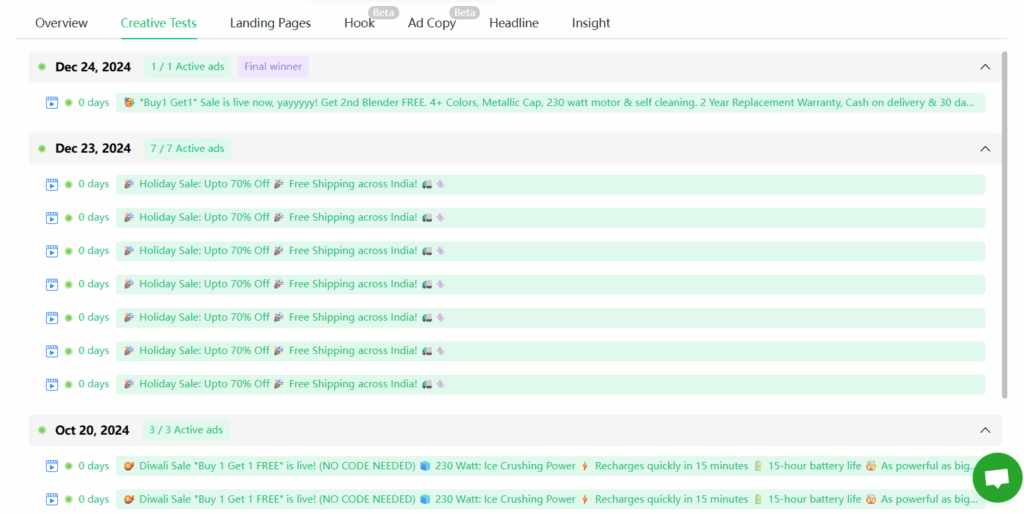
(Tactic 5): Strengthen first-party signals
Andromeda uses signals. If your event and conversion signals are fuzzy (bad pixel, missing server-side events, or poor mapping), the system’s decisions will be noisy.
- Priority actions: Implement Conversion API (CAPI), fix pixel discrepancies, and enrich events with value and content metadata. The clearer your signals, the better Andromeda can attribute intent and optimize delivery.
Integrate CAPI and event data
Server-side events reduce signal loss from browser restrictions and give you a more complete customer journey. Include custom events (e.g., “add to wishlist,” “repeat purchase intent”) so Andromeda can learn beyond simple last-click conversions.
(Tactic 6): Optimize for long-term value
Short-term CPA is tempting, but Facebook Andromeda is capable of optimizing for long-term signals if you feed it the right objective data.
- Strategy: Move from single-conversion goals to value optimization — track repeat purchases, subscription signups, and retention events. Teach Andromeda to prefer customers who have higher lifetime value (LTV).
Track LTV, not just CPA
Measure cohorts and set LTV windows (30/90/365 days) depending on your business. If your product earns more over time, reward the algorithm with that data so it can prefer long-term winners over cheap, one-time buys.
(Tactic 7): Keep adapting to algorithm shifts
Andromeda will evolve. The campaigns that thrive are the ones built for continuous improvement — small experiments, fast loops, and ruthless pruning.
- Routine: Weekly creative refresh, daily signal checks, monthly deep dives. Treat your ad account like a living organism that needs feeding and trimming.
Refresh creatives and budgets weekly
Set a simple rule: if a creative’s CTR or conversion rate drops more than X% week over week, push an alternative asset. Rotate budgets toward winners but keep at least 1–2 experimental slots to discover new angles.
Putting It All Together
Step-by-step campaign setup
- Build a creative pool (8–12 assets per funnel).
- Configure one campaign + one broad ad set for prospecting.
- Implement CAPI and confirm pixel health.
- Launch with Advantage+ enabled but with manual KPI thresholds.
- Run structured A/B tests and rotate assets weekly.
(Full step checklist and templates will appear in part two.)
Ongoing optimization checklist
- Daily: signal monitoring, budget pacing.
- Weekly: creative rotation, top/bottom performer analysis.
- Monthly: LTV cohort review, budget reallocation across audiences.
KPIs that truly matter
- Short term: CAC, CPA, CTR, conversion rate.
- Mid term: 30-day ROAS, retention rate.
- Long term: LTV, repeat purchase rate, margin per customer.
Common Mistakes to Avoid
Over-segmenting audiences
Splitting audiences into dozens of tiny ad sets starves each variant of impressions and confuses Andromeda. Consolidate and use exclusions instead.
Ignoring creative quality
If your creative fails to convey value in 1–3 seconds, Andromeda will filter it out. Good creative is non-negotiable.
Overreliance on manual control
Manual bidding and micro-tweaks are not the primary growth lever post-Andromeda. Use human control strategically, not obsessively.
Weak tracking setup
Poor tracking = poor optimization. Fix CAPI, pixel, and event mapping before blaming the algorithm.
Putting It All Together
Once you understand Facebook Andromeda’s logic and have tested various strategies, the next step is execution. Implementation is where great ideas turn into profit — and it’s also where most advertisers fail. Let’s break down how to combine these insights into a unified campaign system that keeps learning, adapting, and improving.
Step-by-step campaign setup
Think of your Facebook Andromeda campaign as a living organism — it needs structure, nourishment, and consistent evolution.
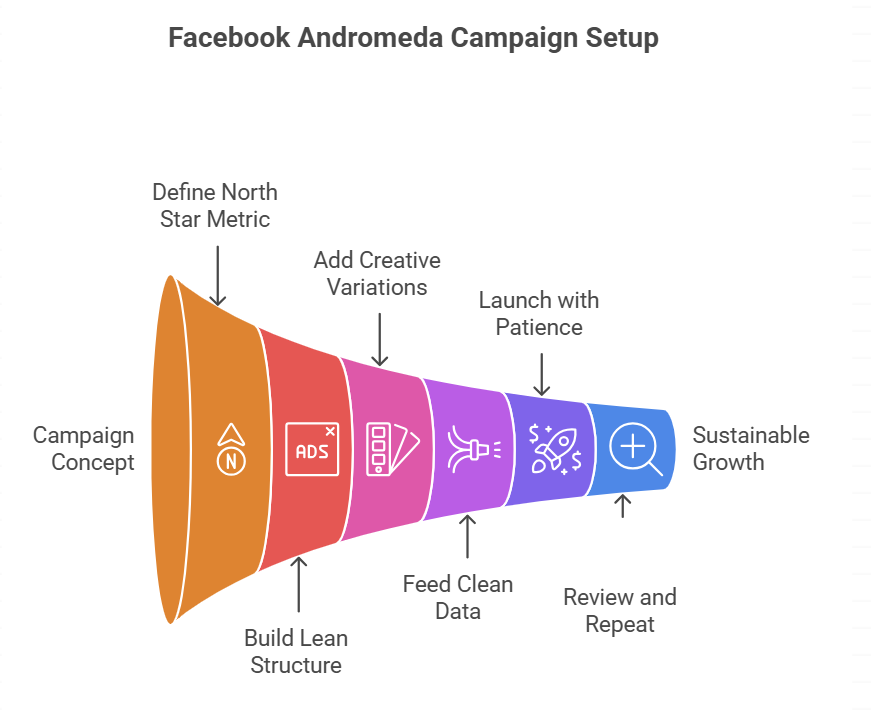
- Step 1: Define your north star metric. Instead of chasing vanity numbers like CTR or impressions, focus on metrics that correlate with growth — ROAS, LTV, or purchase volume.
- Step 2: Build a lean campaign structure. Adopt the one campaign, one ad set rule. Too many ad sets slow down learning and scatter your data. Under Andromeda, the system prefers aggregated data.
- Step 3: Add creative variations. Start with at least 3–5 distinct creative directions, not just visual tweaks. Each ad should represent a different angle, storyline, or emotional hook.
- Step 4: Feed the machine with clean data. Use CAPI integration, fix event priorities, and ensure pixel accuracy. The Facebook Andromeda algorithm is data-hungry — garbage in, garbage out.
- Step 5: Launch with patience. Avoid constant manual interference in the first 72 hours. Andromeda’s learning phase thrives on consistent signals. If you tweak budgets too soon, you reset the process.
- Step 6: Review, replace, repeat. After 7 days, analyze winners and losers. Kill low performers and introduce new creative variants. This cycle fuels sustainable growth.
Ongoing optimization checklist
Staying consistent beats chasing the next “hack.” Create a weekly ritual — a checklist that aligns your team and keeps your campaigns sharp under Facebook Andromeda’s evolving logic.
- Review creative CTR and hook performance
- Audit event data in Events Manager
- Rotate 20% of creatives weekly
- Maintain broad targeting (don’t over-filter)
- Compare CPA trends by week, not by day
- Update ad copy to reflect cultural or seasonal shifts
- Keep at least one experimental campaign running
This checklist helps advertisers stay disciplined. It transforms chaotic decision-making into a rhythm of data-driven iteration — the exact balance Andromeda rewards.
KPIs that truly matter
Under Facebook Andromeda, the metrics that define success have changed. The old obsession with CTR, CPC, or short-term CPA is outdated. What truly matters now is sustainable performance.
- LTV (Lifetime Value): If you’re not measuring this, you’re not optimizing for profit — you’re optimizing for luck.
- MER (Marketing Efficiency Ratio): A better top-down metric to understand ad spend efficiency across platforms.
- Creative CTR: A proxy for audience resonance — if this drops, your storytelling needs work.
- Cost per Incremental Customer: A deeper view of how your campaigns contribute to actual customer growth.
- Learning Stability: Track how long campaigns stay in “learning limited” mode — the shorter, the better.
Tools like Denote can help track and visualize these deeper performance signals, combining creative insights with hard data to give you a complete picture of what’s truly working.
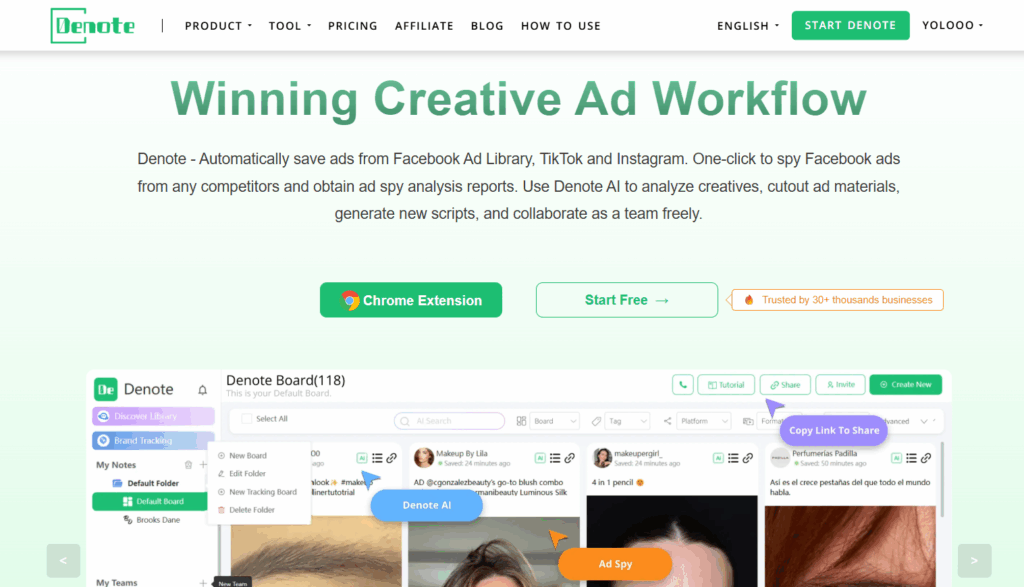
Common Mistakes to Avoid
Even the most advanced advertisers fall into traps — habits that made sense before Facebook Andromeda, but now actively hurt performance. Avoiding these pitfalls can save you thousands in wasted spend.
Over-segmenting audiences
In the past, segmentation meant precision. Under Facebook Andromeda, segmentation means fragmentation. When you slice audiences too thin, you starve the system of data.
Think of Andromeda as a chef — it needs all the ingredients (signals) to cook a perfect dish. If you give it crumbs, it can’t perform magic. Stick to broad targeting and let the algorithm refine the edges.
Ignoring creative quality
No amount of targeting or bidding can save a boring ad. Yet, many advertisers still overanalyze audience data while neglecting the single most important lever: creative.
- Your creative is your targeting.
- Your creative is your algorithm training data.
- Your creative is your brand’s voice.
Use platforms like Denote to manage and analyze your creative performance. It helps you track which visuals or hooks are driving actual conversions, not just engagement. Under Facebook Andromeda, this insight compounds like interest.

Overreliance on manual control
Micromanaging bids and budgets feels productive — but under Facebook Andromeda, it’s counterproductive. The new system learns dynamically. Constant manual adjustments interrupt that process, causing campaigns to re-enter the learning phase.
Instead of fighting the system, partner with it. Set smart rules — for example, pause ads with ROAS <1.2 after 3 days, or scale budgets by 20% increments. This hybrid model balances automation and human oversight.
Weak tracking setup
The silent killer of great campaigns is bad data. Without reliable tracking, even Andromeda’s smartest AI can’t optimize effectively. Ensure:
- CAPI (Conversions API) is properly connected
- Domain events are prioritized
- UTM tracking is consistent across campaigns
- Offline conversions are uploaded regularly
If you skip these, your campaigns become data-blind — and Facebook Andromeda can’t correct what it can’t see.
Conclusion
Facebook Andromeda isn’t just another update — it’s a philosophical shift in how Facebook ads work. It’s about partnership between machine intelligence and human creativity.
Advertisers who cling to the old ways will struggle. Those who adapt — focusing on creativity, data quality, and broad signal strength — will thrive.
In this new world, success comes from simplicity, patience, and structured experimentation. The brands that master these principles will see compounding returns that feel almost magical.



